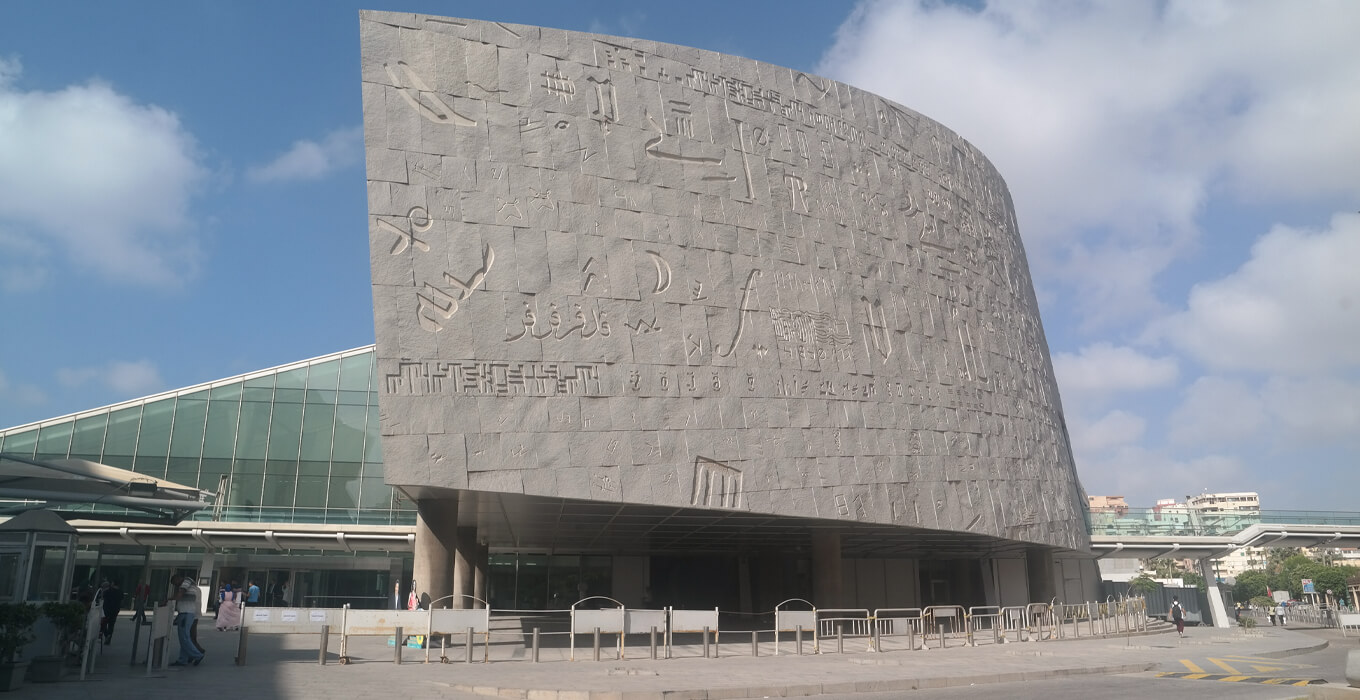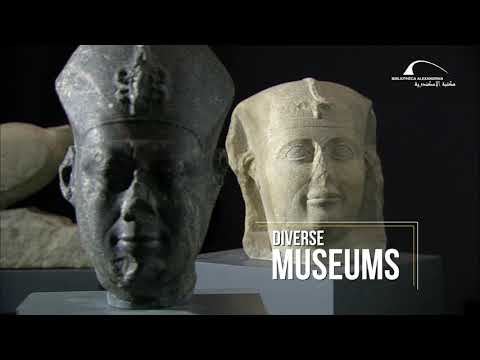The New Library of Alexandria is known as the Bibliotheca Alexandrina. It honors the ancient Library of Alexandria, once a top spot for knowledge. Opened in 2002, it cost $220 million to build. This library is in Alexandria, by the Mediterranean Sea.
It aims to bring back the spirit of its famous past. It’s a place for learning, culture, and education. The library is a symbol of knowledge and history.
Key Takeaways
- The New Library of Alexandria is a $220 million project designed to commemorate and revive the legendary ancient Library of Alexandria.
- The library’s main reading room covers an impressive 70,000 square meters and is capable of housing approximately 8 million books.
- The library’s unique architectural design features Aswan granite walls adorned with carvings representing 120 different scripts, as well as a massive 160-meter glass sundial on the roof.
- The Bibliotheca Alexandrina offers a wide range of cultural and educational resources, including several individual libraries, exhibition galleries, a planetarium, and a manuscript restoration laboratory.
- The New Library of Alexandria is recognized internationally as a hub of excellence and innovation, and it houses a “book print on demand” facility for visitors.
Introduction to Library of Alexandria
The New Library of Alexandria honors the ancient Library of Alexandria. It was a key place for learning and scholarship in the Ptolemaic Dynasty in Egypt. Founded around 295 BCE, it had millions of scrolls and was a treasure of ancient knowledge.
This loss was a big hit to keeping our cultural heritage alive. The modern project to revive the Library of Alexandria shows how important it is to keep and share knowledge. It aims to bring back the old library’s spirit with a modern facility for research and learning.
This new library is a key spot for keeping the ancient library’s legacy alive. It’s a place for sharing knowledge and honoring the past. It’s a symbol of the importance of the ancient Library of Alexandria during the Ptolemaic Dynasty in Antiquity.
Historical Background of the Ancient Library of Alexandria

Ptolemy I Soter started the Library of Alexandria to gather all the books in the world. It grew to be one of the biggest and most important places for ancient knowledge. The library had books in many languages, focusing on Greek literature.
Its decline and destruction is still a mystery. Losing this library was a big loss. It took away a valuable place for knowledge and learning from the Ptolemaic Dynasty era.
Architectural Grandeur
The New Library of Alexandria is a modern architectural wonder. It was designed from an international contest by UNESCO in 1988. Snøhetta, a Norwegian firm, won from 524 entries, showing its global importance.
Design and Construction
Building the library started in 1995 and finished in 2002, costing over $220 million. It was a team effort between the Egyptian government, UNESCO, and international partners. This shows the global teamwork behind this project.
Exterior Features
The library’s outside shows its stunning design. It has a 32-meter-high glass roof that looks like a sundial, stretching 160 meters across. The walls are made of gray granite, with characters from 120 scripts. This honors the rich cultural heritage it aims to keep alive.
|
Feature |
Description |
|
Glass-Paneled Roof |
32-meter-high, tilted outward toward the sea like a sundial, measuring 160 meters in diameter |
|
Granite Walls |
Carved with characters from 120 different scripts, reflecting the diverse cultural heritage |
|
Architectural Design |
Designed by the Norwegian architectural firm Snøhetta, selected from 524 entries in an international competition |
|
Construction |
Completed in 2002 after an investment of over $220 million, through a collaborative effort involving the Egyptian government, UNESCO, and international partners |
Vast Collections and Resources
The New Library of Alexandria has a huge collection of books and resources. It can hold up to 8 million books. The main reading room is a huge 20,000 square meters.
There are also special libraries for maps, multimedia, the blind, and kids. These specialized libraries help everyone find what they need.
The library got 500,000 books from the Bibliothèque nationale de France. It also got digital archives and collections from the Internet Archive. These additions have made the library even more useful for research.
|
Collection |
Size |
|
Main Library |
Capacity for 8 million books |
|
Specialized Libraries |
Maps, multimedia, blind and visually impaired, children |
|
Donations |
500,000 books from Bibliothèque nationale de France, digital archives from Internet Archive |
The New Library of Alexandria is a key place for learning. It attracts people from all over the world with its huge collections and resources.
Museums and Exhibitions
The Bibliotheca Alexandrina in Alexandria, Egypt, is a modern library and cultural center. It has several museums that draw visitors from all over the world. These museums show the history, art, and culture of ancient Egypt and the Mediterranean.
Antiquities Museum
The Antiquities Museum opened in 2001 and is full of ancient treasures. It has about 1,316 artifacts, including items found underwater near Alexandria. These artifacts span from the Pharaonic to the Islamic eras.
Descriptions are in English, Arabic, and French. Visitors can see artifacts from different times.
Manuscript Museum
The Manuscript Museum at the Bibliotheca Alexandrina is a place for rare manuscripts and books. It started in 2001 and has the biggest digital collection of manuscripts in the world. Scholars can study these ancient texts here.
The museum works with the Manuscript Center to protect and study these valuable texts.
Sadat Museum
The Sadat Museum honors the life of former Egyptian President, Anwar Al Sadat. It has Sadat’s personal items like his military robes and the Nobel Prize medal. Visitors can hear Sadat’s voice and see articles about his life.
The museums and exhibitions at the Bibliotheca Alexandrina let visitors see Egypt’s rich past. They offer a special chance to connect with Egypt’s culture and history.
New Library of Alexandria, Egypt
The Bibliotheca Alexandrina, or the New Library of Alexandria, is in Alexandria, Egypt. It’s at the coordinates 31°12′32″N 29°54′33″E. This library is a new version of the famous ancient Library of Alexandria.
The New Library of Alexandria started in 1989 and opened in 2001. It has a unique design with a 160-meter diameter and a shape that leans towards the water. It can hold up to 2,000 visitors on its seven stacked tiers.
This library has a huge collection, holding over eight million books and manuscripts. It covers 80,000 square meters, making it one of Africa’s biggest libraries. The project cost about $200 million to finish.
Even though it’s big and beautiful, the New Library of Alexandria has funding issues. This might slow it down. But, it’s still a symbol of culture and the legacy of the old Library of Alexandria.

Digital Assets and Technological Advancements.
The Bibliotheca Alexandrina has jumped into the digital world with the DAR system. This system is a digital library that lets people access lots of books online for free. It makes sure the library’s books are safe and easy to find in the digital world.
The DAR has over 130,000 Arabic books you can search for. It also has more than 60,000 items about Egypt’s history from the last two centuries. This gives researchers and the public a deep look into Egypt’s past.
The library is also leading in new tech projects, like the SuperCourse in Public Health and Epidemiology. This online course has over 3,500 lectures in 31 languages. It reaches 65,000 scientists in 174 countries, showing its huge success.
The library’s tech is top-notch, with super-fast internet and a special 3D tool for researchers. It also has huge storage for lots of data, keeping its digital books safe for the future.
The library’s High-Performance Computing cluster is another big deal. It has 11.8 TFLOPS of power, helping scientists and innovators a lot. This makes the library a key place for new discoveries.
Educational and Cultural Center
The Bibliotheca Alexandrina is more than just a place for books. It’s a key spot for learning and culture. It meets the needs of scholars, researchers, and everyone interested in learning.
At its core is a top-notch conference center that can hold thousands. It’s perfect for events like academic talks, cultural shows, and festivals. This makes the Bibliotheca Alexandrina a lively spot for sharing ideas and art.
The library has many specialized libraries focused on different subjects. You’ll find everything from arts to sciences. These libraries offer great digital tools too, giving students and researchers lots of knowledge.
There’s also a cool planetarium that takes you on space adventures. Plus, the library has exhibits on Egypt’s culture and the world’s. It’s a great place for learning and exploring culture.
The Bibliotheca Alexandrina is a big deal worldwide as a cultural center. It mixes learning with art and celebrates our shared culture.
Management and Governance
The Bibliotheca Alexandrina, Egypt’s famous library, has a detailed governance plan. A Presidential Decree runs it, with a Council of Patrons and a Board of Trustees leading the way.
The Board of Trustees runs the library. It has between fifteen and thirty members. This group includes top officials from the Egyptian government. They make sure the library keeps running and growing, matching national goals.
The Director leads the Bibliotheca Alexandrina. They are in charge of everyday tasks and making the library’s big plans happen. With help from the Council of Patrons and the Board of Trustees, the Director has made the library a success since 2002.
|
Governance Structure |
Key Components |
|
Presidential Decree |
Oversees the overall management and operation of the Bibliotheca Alexandrina |
|
Council of Patrons |
Provides strategic direction and oversight for the library |
|
Board of Trustees |
Governing body with 15-30 members, including ex-officio government representatives |
|
Director |
Chief executive officer responsible for day-to-day management and implementation of the library’s vision |
This detailed governance makes sure the Bibliotheca Alexandrina keeps doing well. It remains a key place for learning, culture, and new ideas in Egypt and beyond.
Role in the Arab Spring
The Bibliotheca Alexandrina, Egypt’s new Library of Alexandria, was key during the 2011 Arab Spring. When protests spread, the library closed. But, young people formed a human chain to protect it from harm.
They didn’t just stand by. The library also hosted symposiums in 2011. These talks focused on Egypt’s revolution and important social issues. Everyone could come, showing the library’s dedication to education and community.
The Bibliotheca Alexandrina stood strong during the Arab Spring. It became a place for deep talks and a symbol of Egypt’s culture. Young people showed how important it is to get involved in big changes.
|
Statistic |
Value |
|
Number of people who died during the Egyptian revolution in 2011 |
At least 846 people died, with an additional 6,000 injured |
|
Cost of building the Library of Alexandria in Egypt |
$220 million |
|
Annual investment in the field of librarianship |
Over $40 billion worldwide |
|
Number of registered library users worldwide |
One out of every six people in the world |
|
Comparison of library visitors to professional and college sports attendance |
Five times more people visit U.S. public libraries each year than attend professional and college sports games combined |
The Bibliotheca Alexandrina was a beacon of hope in Egypt’s tough times. It showed the power of coming together and speaking out. Young people proved that this place is vital for change.
Conclusion
The New Library of Alexandria is a tribute to the old one. It was a place where learning and scholarship thrived. Now, it’s a center for knowledge, research, and cultural sharing.
This library has lots of books, special resources, museums, and new tech. It inspires and teaches people. It helps us value knowledge and keep it alive.
The New Library of Alexandria is a place for learning and research. It shows how important knowledge and culture are. Its success shows the lasting impact of the old Library of Alexandria on today’s world.
Read our related articles:


